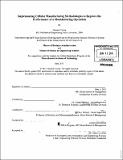Implementing cellular manufacturing methodologies to improve the performance of a manufacturing operation
Author(s)
Correa, Manuel (Manuel Roza)
DownloadFull printable version (9.400Mb)
Other Contributors
Leaders for Global Operations Program.
Advisor
Roy Welsch and Daniel Whitney.
Terms of use
Metadata
Show full item recordAbstract
Many traditional high-mix, low-volume manufacturing facilities utilize process villages, whereby similar operations are grouped together in an effort to gain efficiencies. While process villages can improve certain metrics and increase capacity utilization, many wastes can be created that outweigh most benefits. In many cases process villages operate with large batch sizes, which result in longer lead-times and increased inventories. A different approach, for an appropriate range of product mixes and volumes, is to form production cells for common products that group different processes together to form complete value streams. The manufacturing cells focus on completely finishing products before handing them off and result in reduced lead-times and inventories. This thesis presents a methodology for implementing such production cells in a manufacturing environment. The author spent six months at a leading aerospace company implementing cellular manufacturing principles in designing several production cells for a transmission component manufacturing department as part of a lean transformation effort. The cell design methodology implemented consisted of several key processes such as process flow design, material handling design, workplace organization, and staffing. The process flow design consisted of activities such as grouping products into families, designing value streams, and performing capacity analysis. Material handling design developed solutions for how products physically flow through the cell and managing work-in-process. Workplace organization focused on utilizing visual factory and 5S principles to ensure strong communication and information flow as well as first class equipment organization and housekeeping. Finally, workload analyses were performed to appropriately staff the cells to minimize costs and ensure efficient operations. Ultimately, the goal of any transformation effort is to reduce waste and add value, which would not be possible if the culture of the organization did not support the physical and operational design changes. Hence the final, and arguably most important piece of the transformation, which the author participated in, was engaging the workforce to drive the culture change.
Description
Thesis (M.B.A.)--Massachusetts Institute of Technology, Sloan School of Management; and, (S.M.)--Massachusetts Institute of Technology, Engineering Systems Division; in conjunction with the Leaders for Global Operations Program at MIT, 2011. Cataloged from PDF version of thesis. Includes bibliographical references (p. 62).
Date issued
2011Department
Leaders for Global Operations Program at MIT; Massachusetts Institute of Technology. Engineering Systems Division; Sloan School of ManagementPublisher
Massachusetts Institute of Technology
Keywords
Sloan School of Management., Engineering Systems Division., Leaders for Global Operations Program.